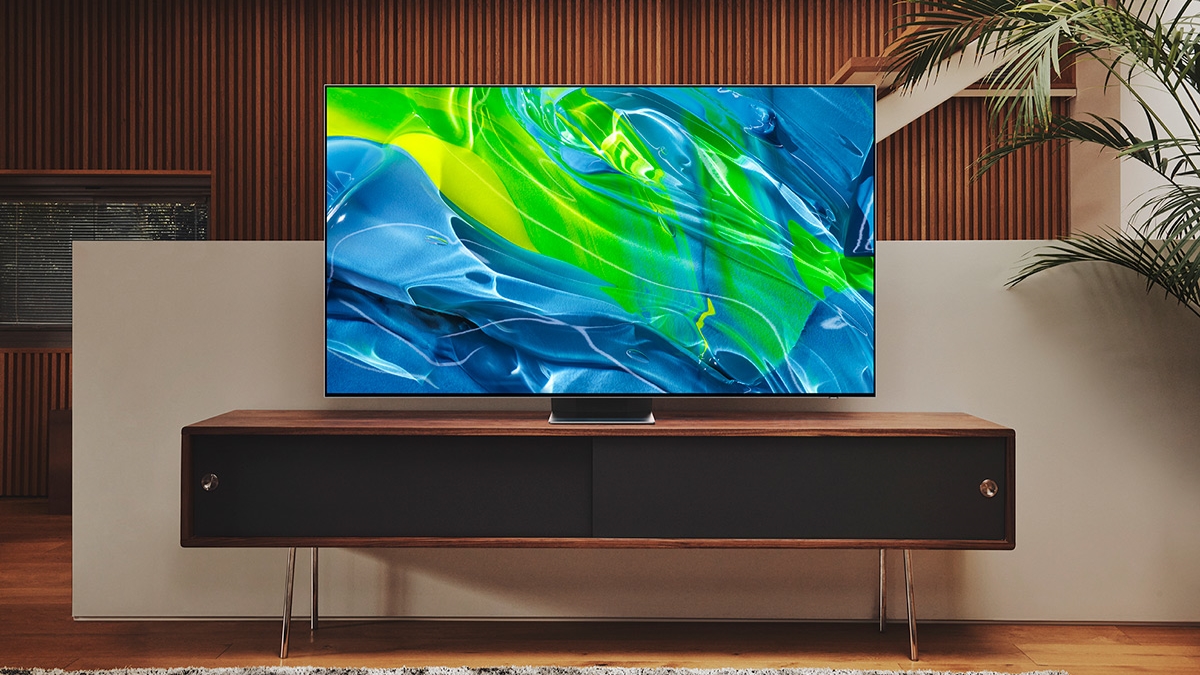Samsung's new OLED tech could mean cheaper QD-OLED TVs
Samsung believes in the blue light

Samsung Display has been working on a new way of producing OLED pixels for its QD-OLED TV panels, according to a presentation by a South Korean professor, reported by The Elec. Specifically. Samsung has been working on a better kind of blue OLED pixel, and this could be just the boost the technology to needs to be able to start dropping its prices and competing directly with the regular (and cheaper) OLED panels used in the best OLED TVs currently.
Here's the background: red and green OLED pixels are made of phosphorescent materials that provide 100% efficiency for brightness internally. But blue OLED pixels are made from florescent materials that provide only 25% efficiency.
Unlike regular OLED screens, which use red, green and blue pixels together to make colors, QD-OLED screens only used blue and green pixels (with the layer of quantum dots converting the light to other colors). The Elec notes that currently, QD-OLED screens use three layers of blue pixels (because their efficiency is so limited), and one layer of green pixels.
Samsung Display's research was apparently to create a phosphorescent blue pixel, hopefully bringing the blue efficiency up to match the other colors – the company has already published a paper based on its work. But according to Professor Kwon Jang-hyuk of Kyung Hee University, Samsung is "prioritizing applying phosphorescent blue OLED material on its advanced TV panel," says The Elec.
Professor Kwon said that "Samsung Display likely had made a process on developing phosphorescent blue OLED material" in practice, not just in theory, and he said that Samsung intends to show off something using the new tech "within the year".
The advantage here is that Samsung wouldn't need to use four layers of pixels anymore – it could reduce it down to just two: one layer of blue, one layer of green. This would reduce both the materials needed and the complexity of production of its OLED panels – it would make them more efficient to produce, as well as more efficient at putting out light.
More efficient production means cheaper production, and with QD-OLED TVs currently ranking right at the very top of 4K TV prices, a price drop is exactly what they need to take them mainstream.
Get daily insight, inspiration and deals in your inbox
Sign up for breaking news, reviews, opinion, top tech deals, and more.
TechRadar has contacted Samsung Display for comment.
- See Samsung TV deals in our 2022 Memorial Day sales guide
Analysis: A realistic claim, and might be necessary
As also noted by The Elec, Samsung Display isn't the only company zeroing in on creating viable phosphorescent blue OLED pixels. UDC, which is based in the US, has said that it plans to bring the technology to market in 2024, so assuming that's true, it certainly doesn't seem unlikely that Samsung Display would be able to achieve it at around the same time, or even slightly earlier.
The first QD-OLED TVs – the Sony A95K and Samsung S95B – are extremely high end. With some regular OLED TVs now often available for around $1,000 / £1,000 or even less, QD-OLED looks to be a long way off from being able to match that. But as the cost of living crisis goes on, the market for premium TVs might get pinched, with people choosing to save money and get a TV that's 95% as good for half the price.
The sooner Samsung Display can reduce the price of creating QD-OLED panels the better, because it's an incredibly exciting technology, and we'd hate to see it get left behind. Between Samsung Display generally being able to improve production yields (reducing costs) and the promise of this new technology, it looks like the company's got a bright future. (Sorry.)

Matt is TechRadar's Managing Editor for Entertainment, meaning he's in charge of persuading our team of writers and reviewers to watch the latest TV shows and movies on gorgeous TVs and listen to fantastic speakers and headphones. It's a tough task, as you can imagine. Matt has over a decade of experience in tech publishing, and previously ran the TV & audio coverage for our colleagues at T3.com, and before that he edited T3 magazine. During his career, he's also contributed to places as varied as Creative Bloq, PC Gamer, PetsRadar, MacLife, and Edge. TV and movie nerdism is his speciality, and he goes to the cinema three times a week. He's always happy to explain the virtues of Dolby Vision over a drink, but he might need to use props, like he's explaining the offside rule.